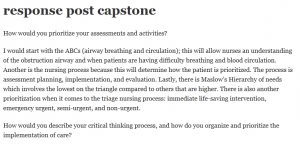response post capstone

How would you prioritize your assessments and activities?
I would start with the ABCs (airway breathing and circulation); this will allow nurses an understanding of the obstruction airway and when patients are having difficulty breathing and blood circulation. Another is the nursing process because this will determine how the patient is prioritized. The process is assessment planning, implementation, and evaluation. Lastly, there is Maslow’s Hierarchy of needs which involves the lowest on the triangle compared to others that are higher. There is also another prioritization when it comes to the triage nursing process: immediate life-saving intervention, emergency urgent, semi-urgent, and non-urgent.
How would you describe your critical thinking process, and how do you organize and prioritize the implementation of care?
Critical thinking allows nurses to come up with answers and gather data and information about their patients. One example is stroke victims and a variety of symptoms. First, I will prioritize the patient concerning MI that may have some dizziness, which will sign that something may be wrong. I would assess to see if there may be a low blood supply going to the patient brain and throughout their circulatory system. This would consider a medical emergency and treat as such for the nursing patient care. If a patient is having a stroke, the first thing the nurse is never to do is give a patient medication, drink, or food because their stroke will affect their ability to swallow. The patient can experience choking and when a stroke patient has these symptoms, look for other factors that play into their diseases, such as blood pressure monitoring, physician orders, and critical care monitoring. Rapid lowering of blood pressure can lead to reducing perfusion in brain tissue. A physician can order a brain CT to rule out a hemorrhagic stroke and monitor blood pressure every 15 minutes to the first hour until the infusion ends the next 6 hours and the post-infusion in 24 hours. The deadliest is when a nurse doesn’t take the patient seriously and ignores the signs and symptoms that can be fatal. Acting on sound judgment immediately can improve the chances of finding an excellent diagnosis, treatment, and recovery. When we think about how a stroke starts when the blood supply goes to one part of the brain and becomes blocked and highly restricted. This will significantly disadvantage the brain tissue of oxygen and nutrients.
2.
Health care assessment is a plan that identifies a specific need of an individual or a society and provides a solution on how those needs can be addressed by the healthcare system or the professional nursing facility. The plan evaluates the health status by conducting a physical examination of the patient after taking information about his or her previous medical health history. The primary purpose of obtaining the patient’s health history is to gather subjective data about the patient’s illness. The information gathered will help to create a plan that helps improve the health status of individuals, address acute health conditions, and minimize the causes of chronic diseases. A registered nurse must gather information about the patient’s physiological, sociological, and spiritual status. This information helps to identify present and future patient care needs, which may involve the help of other specialists and the collaboration of various doctors. When assessing the health care services, it is also crucial to check on the severity of an infection or disease to handle the more risky and critical health conditions most quickly and effectively through having a stand-by emergency care unit.
In the four cases presented in the Intermediate Medical Care Unit, I would prioritize my assessment and activities, considering the patient’s urgent need for care (Types, 2019). In this scenario, the patient experiencing an impending stroke is more critical than the two patients suffering from myocardial infarction, even though the health condition is dangerous. The third patient, experiencing drastic blood sugar fluctuations within a short period, also has a critical health problem; the high blood sugar levels may lead to further complicated conditions such as high blood pressure. The patient presented with a Transient Ischemic Attack needs less attention since it only leads to a brief interruption of blood flow to the brain and may cause the individual to experience temporary stroke-like symptoms. The condition is not as severe as the others since it only lasts for a short time; hence, the patient can be handled after dealing with more life-threatening conditions. Therefore, the priority of care will be given to the patient experiencing high fluctuations in blood sugar levels and the other two who are presented with Myocardial infarction, respectively. My critical thinking process, especially in this case, is mainly governed by problem-solving skills. This process involves developing solutions based on the information at hand (Articles, n.d.).
rubric : respond to the discussions post at 100 word a piece